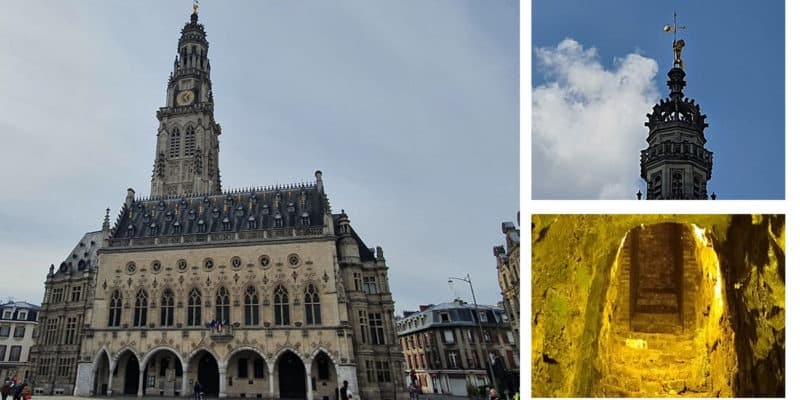The Arras Belfry is a magnificent historic building located in the heart of the city of Arras. If you’re planning a trip to the Hauts-de-France region, the Belfry is well worth a visit, if only to admire the city from above or to discover the boves (the underground galleries as seen in the image at the top of our topic). In this blog post, we’ll give you a brief overview of the Belfry and what you can expect during your visit.
The difference between the Belfry and the Town Hall
The people of Arras often confuse two things: the Belfry and the Town Hall. In fact, the Belfry is the tower that rises to a height of almost 75 meters, while the Town Hall is the building that surrounds it. When visiting the town, from Monday to Sunday, it is generally advisable to go to the Tourist Office in the Town Hall, right next to the high tower, which can be climbed every day from 09:30 to 12:00 and from 14:00 to 17:30.
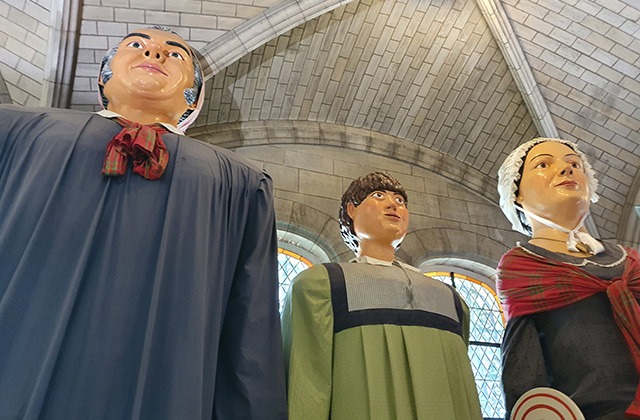
The Arras Giants at the entrance to the Town Hall
The Arras Belfry to See by elevator
Visiting the Belfry means taking an elevator and a forty-step walk to see the heights of the city. You’ll be able to see the original architecture of the houses in the different neighborhoods, see both the town and the city, and look out over Lorette and Vimy Ridge, one of the tragic battlefields of the Great War. From the moment you reach the carillon bells mentioned below, you’ll have to climb the steps to find yourself under the golden lion.
The Belfry carillon
The carillon, located between the 2nd and 3rd crowns, is made up of 37 bells. The instrument was built in the early 18th century and was used to alert residents in the event of fire or other emergencies. Today, following the reconstruction of the Belfry in 1924 by Pierre Paquet, the carillon is operated manually by a team of bell ringers. The bells are operated using a system of pulleys and ropes, and music is created by striking the bells with hammers. The carillon is a popular tourist attraction, and visitors can often hear the bells ringing throughout the day. Although the Belfry was built in the 15th century (finished in 1551 by Jacques Le Caron), its bells have been playing folk songs since 1830. The most popular of these tunes is “On ira voir la fête d’Arras” (Iras-tu vir el’ fête d’Arras, in patois), which was created for the first Arras festival. The song has its roots in a 16th-century folk tune, and its catchy melody has made it a favorite with locals and visitors alike. On the half-hour, the Belfry also plays the aria from Daniel-François Esprit-Auber’s 1930 opera Fra Diavolo (or Hotel de Terracine). On the quarter-hour, it plays a simple arpeggio, and on the three-quarter-hour, it plays it three times.
The Town Hall
While the Belfry was rebuilt twice in 1840 by Joseph Traxler (at the time, the building was in danger of collapsing, even though it was listed as a historic monument by Prosper Mérimée), the one we know today is the work of architect Pierre paquet. One of the city’s most emblematic buildings, the Hôtel de Ville was first built in 1501, and enlarged twice over the following decades. The first enlargement took place shortly after the initial construction, and the second in 1572. The town hall was destroyed during the First World War, but was subsequently rebuilt identically.
Post-war reconstruction
The town hall was destroyed by German artillery during the First World War. It was set on fire on October 7, 1914. While the destruction of the belfry was a great loss for the city of Arras, it was not the end of the story. The Belfry was rebuilt after the war, and today stands as a testament to the city’s resilience. Pierre Paquet, the historical monuments architect in charge of reconstruction in Arras, chose a reconstruction faithful to the building’s general exterior appearance at the end of the 16th century. The interior was also decorated with a blend of neo-Gothic (cross vaults in the entrance), Flemish neo-Renaissance (the marouflaged tapestry in the reception room tells the story of local history in the 16th century) and Art Deco (wrought-iron railings, staircase, upstairs offices) in a surprisingly homogeneous and elegant whole. But it’s the first floor in particular that really catches the visitor’s eye.

View of the Hauffbauer tapestry.
One can recognize the Brueghel style, an example of which is in the Arras museum.
Hoffbauer’s fresco in the village hall
Hoffbauer’s fresco, inspired by Brueghel the Elder, in the village hall, is a response to the sculpted panels of hundreds of figurines. The 800 figures in the fresco are quite mischievous, interacting with the figurines in a variety of ways. Some are frightened by the figures, while others are amused. The fresco is a lively, vibrant work of art that brings the party room to life. Note the expressions of religious figures around the mantelpiece, in reference to the Cité de l’évêché section, and the references to the Ville section, with a view of the 16th century Belfry (unfinished). On the mantelpiece itself, a reference is made to the town’s rats (known as ville de rats or fêtes des ras for strictly phonetic reasons with its name).
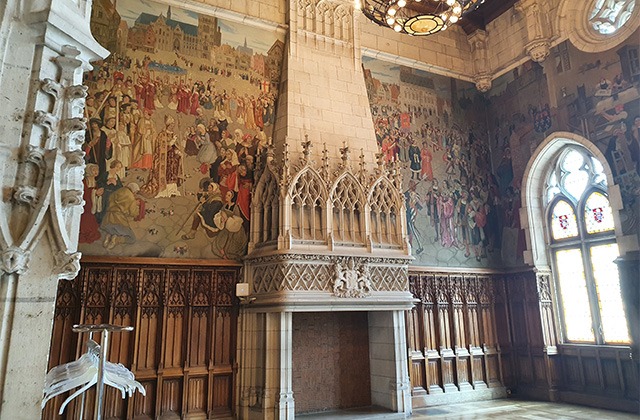
The fireplace in the village hall
Wedding hall and council chamber
The wedding hall is where couples pass in front of the mayor and deputy mayors for their vows. It’s a small room compared to the village hall, but it also boasts a beautiful marouflaged fresco with numerous art deco female representations. The Mariane, not personified, is enthroned behind the mayor’s desk and also dates from the 1930s. Many small objects can also be seen in a display case, including the keys to the city.
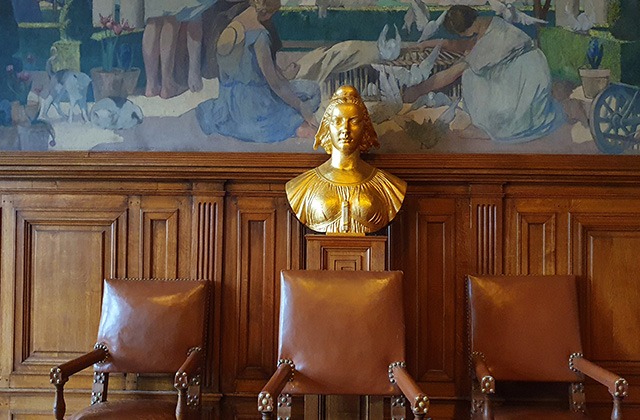
La Mariane wedding hall and leather armchairs
The functional furnishings also date from the thirties, and the woodwork is oak from World War I tributes.
The council chamber
Immediately note at the entrance the plaque commemorating the Nazi executions during the Second World War.
Many people were sentenced to execution or deportation here.
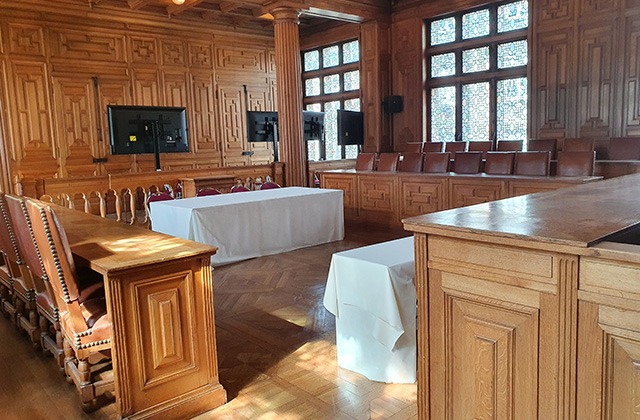
Arras City Council Chamber
Once again, art deco is in evidence in the furniture and frescoes. Behind the seats of the mayor and deputy mayors, a fresco depicts Jehan Bodel and Adam de la Halle (already mentioned on our blog during the “Fête de a Musique“). If you’d like to attend a town council meeting, these take place at least once a month.
R.C.
